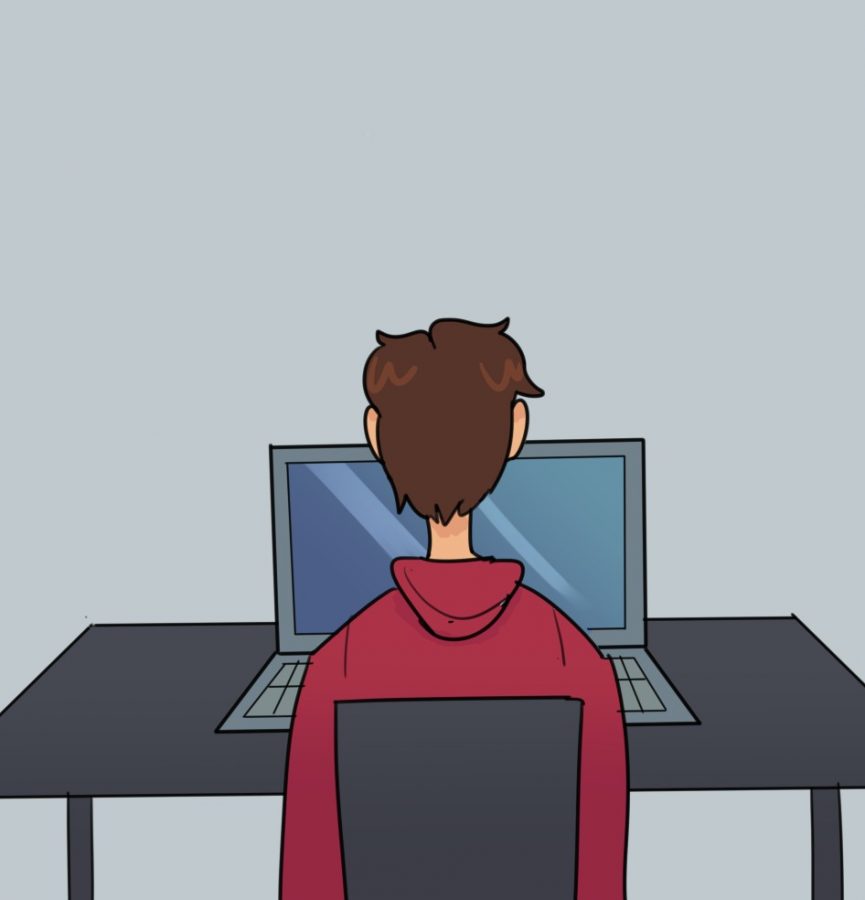For now, at-home learning is what’s best for Edina students
Seven months into the COVID-19 pandemic, the world isn’t getting any more used to it. People are desperate to get back into offices and restaurants, and they long for the socialization we all once took for granted. Reopening processes are beginning, albeit slowly, including Edina High School students being given the option of hybrid learning this semester. However, a month into the 2020-2021 school year, it still seems that Edina Virtual Academy, or EVA, is the more enriching choice.
Hybrid students come into school two days a week. The first half of the alphabet takes Monday and Tuesday, followed by the second half on Thursday and Friday. Their masks stay on the entire time as they sit in quiet, nearly empty classrooms, appropriately socially distanced from their fellow scholars. These are, of course, measures EHS is taking to keep its students and staff safe, the importance of which should not be undermined. Nevertheless, it makes for an uncomfortable, almost dystopian atmosphere that is sure to wear on the psyche of Edina’s teens. With half their friends gone, designated walkways, and an invisible six-foot forcefield around each kid, the social aspect of going to school is just about eliminated.
School is looking like something out of a “Hunger Games” novel. Teens are craving familiarity, and nothing is more familiar than one’s own home. EVA students reap the benefits of being able to learn right from their bedrooms and are able to do their assignments at their own pace, step outside for a quick breath of fresh air, and even get a few extra minutes of sleep each morning. All of these add up to a more eased mindset in this world of discomfort. And don’t think that online learning is making students into hermits; EVA students have the opportunity to collaborate with one another through FaceTime and other digital avenues, making for arguably more communication than hybrid students are getting.
The most obvious advantage to hybrid learning is the chance for students to make meaningful connections with their teachers. Communicating through a screen is never the same as a face-to-face conversation. But with COVID keeping us apart, and even the way we use technology today, is that connection even there? Kids coming into school are still spending some entire class periods on Google Meets, despite the fact that their teachers are right there in the room. Teachers are having to juggle keeping both their online and in-person students engaged in their learning, which is not an easy feat. They’re having to create two separate curriculums that fit the needs and accessabilities of every kid under their supervision. This is a lot to ask from a group of people already working ridiculously hard everyday to shape today’s youth into successful, hard working adults.
The last few months have brought altered routines, changes in the way we must behave, missed life events, and all kinds of other hardships. Teens are not as well-suited to constant adaptation as adults are. A survey conducted by the Center for Disease Control in June stated that 40.9% of interviewees noticed “at least one adverse mental or behavioral health condition” brought about by today’s coronavirus climate. A whopping 10.7% of respondents had considered suicide in the last 30 days. This was coming from presumably well-adjusted adults. If that’s where they were at, there’s no telling what the average hormonal, emotional teenager could be feeling. Furthermore, according to medical journal JAMA, a second wave of mental health struggle is on the way. The best way for us to prepare our teens is to give them a sense of routine, comfort, and familiarity, one that cannot be instilled by the plexiglass barriers and mask-clad faces of hybrid learning. Online school gives students a chance to look around them and see something they recognize, something that feels like home.
Come second semester, EHS will hopefully have more opportunities to get more kids in school learning, together. But for now, it’s just not plausible. We all did online learning last spring and did well with it, so we know it’s an option. It’s just a matter of determining which option is best suited for each student individually.

If you’ve ever had the pleasure of shaking Hanna Jaeger’s hand, you’ll know they are extremely clammy. As a self-identified 45-year-old man, Hanna...
Being in school is invaluable
School is an invaluable piece in the development of students on both a societal and intellectual level. Although students faced a culture shock when returning to school, being in-person provides many things online learning cannot: reconnecting with people, accountability standards, and a sense of normality. The principle goal of school is to provide students the assets they need to succeed in a capitalist workforce. From home, these skills cannot be mastered in the same way as they are expected to in school.
Quarantine was a life-changing experience for all of us. Without societal standards to keep us in the box of conformity, many of us hatched out of quarantine a new person. Some people came out, others cut their hair or dyed it, and all of us learned how to be alone. Quarantine in itself was a mental battle for everyone. The separation from people lessened the weight of society’s vision of a perfect person and allowed room for personal growth and experimentation.
Being introduced back into an in-person world was scary, to say the least, but it was necessary. While we stumbled around social interaction that had been missed, our struggles served as a reminder that in the workplace, bosses expect our people skills to be impeccable. Be it a positive or negative moral, competition is a valued American ideal that demands professionalism. While culture binds us to an idea of perfection, it also provides a set of standards that prevents people from straying too far from what is humane. Whether society is a monster of conformity or a form of regulation, it exists in the workforce in a larger sense than in high school.
This is the purpose of high school—to prepare students to succeed in the workforce. Being in school provides a standardized place for social development to progress. It is important as a student to be directly in contact with teachers in a setting that demands respect for authority. Accountability to do work to the best of your ability is forced upon you when a teacher calls you out for not doing homework, and learning is easier when you can engage and ask questions instead of mindlessly watching a video. When a student is forced to confront a teacher for help or to point out a mistake, skills that are necessary in the workforce are demonstrated.
Nevermind school as a learning place, it is so important to be among peers and see friends that would not otherwise be seen outside of school. The Center for Disease Control and Prevention states that being physically at school can, “provide opportunities to facilitate social-emotional development that are difficult, if not impossible, to replicate through distance learning.” Being surrounded by people was missed in lockdown and has made us recognize the value of friends and family. Simply being surrounded by other students in the same situation is a reminder that nobody is alone.
Yes, changes need to be made to the educational system to better fit the needs of all students. Yes, school is exhausting. For people with barriers to their education like mental illnesses or problems at home, school can be especially difficult to thrive in. Learning time management and how to deal with stress is even more important to students struggling with these things. School is an opportunity to practice for when a time comes in which you are busier than ever before—adulthood. Learning at home is simply impossible for many students. The stress caused by family and access to the internet and food is diminished when attending school. School could be modified to appease the needs of all students, but even for the ones who are struggling, it is the right place to be.
In the end, school is the best place for everyone. It provides mental relief in the presence of peers while also developing functioning citizens. I concede, school causes everyone copious amounts of stress, but I also acknowledge the skills and endeavors I am able to partake in due to school. It is a necessary component of the happiness and progression of education in order to prepare students for the workforce.

Senior section editor and avid bandie, Maren Fullerton balances concert, jazz, and marching band along with varsity soccer and basketball. With the little...
